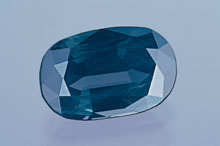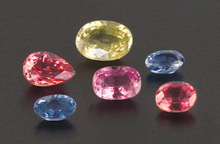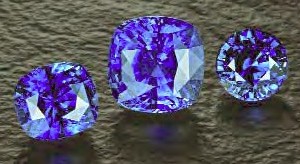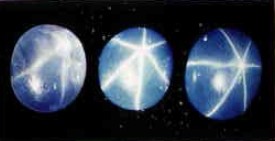Sapphire - Not just blue
Sapphire, the birthstone for
September, has a name that is known and prized throughout the world. Yet when the public thinks of sapphire invariably
it is as a blue gemstone; the name itself comes from a Latin word that means
"blue". This is unfortunate, because sapphire
occurs in a wide range of colors and many of these hues are much rarer than the blue
shades. The red variety of sapphire has
a special name: it is called "ruby". Both sapphire and ruby are a gem varieties
of the mineral corundum: the only difference is the trace elements which give them their
rich colors. Ruby is the red version, and the term "sapphire" applies to all the
non-red colors of the mineral corundum that are cut as gemstones, not just the blue
variety. The other colors of sapphire can be just as beautiful and rare - or even rarer -
than the blue, but they are usually priced less. Yellow, orange, lavender, and other
pastel shades are especially affordable - and often very beautiful. Sapphire gems in colors other than blue are often
referred to as fancy sapphire.
Because sapphires represent divine favor, they were the gemstone of choice for kings and high priests. The British Crown Jewels are full of large blue sapphires, the symbol of pure and wise rulers. The most famous and valuable sapphires are a rich intense blue, a truly royal hue. Sapphire is also the birthstone for September, the month when the most babies are born. Ancient lists also name sapphire as a birthstone for April and the gemstone for the sign of Taurus.
Sapphire is perhaps the toughest and most durable gemstone available on the market. With a hardness of 9 on the Mohs scale, sapphire is harder than any other gem but diamond and it has no cleavage plane so it cannot be cut with a single blow like a diamond. In fact, synthetic sapphire is used for scratch-resistant watch crystals, optical scanners, and other instruments because its durability can be trusted. That same durability ensures that sapphire jewelry will be treasured for generations.
Check out my web page on digging your own sapphire gemstones in the state of
Montanta:
Digging For Your Own Montanta Sapphires
TREATMENT OF SAPPHIRE
Sapphires have become more available in the past twenty years because
some light, cloudy, or over dark sapphire can now be heated at very high temperatures to
improve the color or clarity. This process, which dissolves trace elements already present
in the sapphire, is completely stable. There is no significant price difference between
heated and non-heated material except for at the very top of the market, where the country
of origin will also make a difference in the price. About 90 percent of the sapphire on
the market today has been heated to make sure it has reached the best possible color and
clarity. This type of treatment is permanent, and is probably of little concern to most
buyers.
In recent years a treatment called "surface diffusion" has been developed to
produce pinkish-orange colors from lighter colors. A trace of the element Beryllium is
added to the stone during this treatment. If Titanium is added instead of Beryllium,
during the process, near colorless stones can be treated to a good blue color. It is
considered permanent, but surface diffusion stones are significantly less valuable than
stones with color all through the stone, because if a stone has to be re-cut because of
damage or scratching, the re-cutting will remove the thin surface layer of color.

Sapphires come from Sri Lanka, Thailand, Australia, and Cambodia. Nigeria, Kenya, Tanzania, China, Vietnam, Madagascar, and the United States. The deposits in Montana in the United States produce a range of fancy colors, mostly from alluvial deposits in the rivers, and deep blue sapphires from one of the world's largest deposits at Yogo Gulch. The sapphires from Yogo Gulch are small in size but they have a beautiful blue. Unfortunately they are found in a hard rock that makes mining difficult, limiting production.
The most famous sources for sapphire are Kashmir and Myanmar (a country was formally known as Burma). The Kashmir sapphire, which was discovered in 1881 when a landslide in the Himalayas uncovered beautiful blue pebbles, has a rich velvety color prized by connoisseurs. Burma sapphires, from the same region that produces fabulous rubies, are also very fine. However, today, these two sources account only for a very small quantity of the sapphire on the market.
Much of the fine sapphire on the market today comes from Sri Lanka, which produces a wide range of beautiful blues from delicate sky blue colors to rich saturated hues. Yellow sapphires from this locality are magnificent, and may reach sizes of several hundred carats. These large stones are museum pieces, yet are surprisingly inexpensive despite their great rarity. Pink and violet sapphires from Sri Lanka are extremely intense and vibrant in their coloration and are generally much rarer than blue sapphires. Kanchanaburi in Thailand and Pailin in Cambodia are renowned for deep blue, even colors. Two relatively new mining localities are showing promise: Madagascar, which has produced some exceptionally fine stones in small sizes but has no organized mining yet, and Tanzania, which has long produced sapphire in other colors but is starting to produce blue colors as well from a deposit at Tunduru.
A recent discovery on the Island nation of Madagascar has begun to produce some fine sapphire in both pink and fine blue colors. The region producing the sapphire is large, and many hope that this new area will be producing large quantities of fine sapphire for many years to come.
Green sapphire comes from Cambodia, but the color is usually muddy
and unattractive (with a few very rare exceptions); Dark blue and yellow sapphires also
come from Australia, but are so scarce that few are available in the world marketplace.
All colors of sapphire share the magic of this ancient name; it is only a matter of time
before the non-blue colors are recognized and demand brings their price levels up to par
with the popular blue stones.



The most valuable of the fancy sapphires is a orange-pink or pinkish-orange called "padparadscha" after the lotus blossom. Padparadscha sapphires are very rare and the exact definition has always been a matter of debate: different dealers and different laboratories around the world disagree on the exact color described by this term. Some dealers even argue that the term should not be limited to the pastel shades of Sri Lankan sapphires but should also include the more fiery shades of reddish-orange from the Umba Valley in Tanzania. Padparadscha sapphires sell at a premium, sometimes approaching the price for a fine blue sapphire. Although the exact description is debated, the beauty of these rare gemstones is not, with their delicate blended shades the color of fresh salmon and sunsets. Other very popular shades of fancy sapphires are yellows, bright oranges, lavender and purples, and a bluish green color.
Generally, the more clear and vivid the color, the more valuable the
fancy sapphire. If the color is in the pastel range, the clarity should be good: because
in lighter tones inclusions are more noticeable, the trade usually prefers the gemstones
to be cleaner with fewer visible inclusions. In a lighter colored gemstone, the cut is
also more important: it should reflect light back evenly across the face of the stone,
making it lively and brilliant. With darker more intense colors, the cut is not as
critical because the color creates its own impact. Stones too dark to give good return of
light and sparkle are also valued less.
Sapphires are most often cut in a cushion shape - a rounded rectangle - or an oval shape.
You can also find smaller sapphires in round brilliant cuts and a wide variety of fancy
shapes, including triangles, squares, emerald cuts, marquises, pear shapes, baguette
shapes, and cabochon cuts, or smooth domes. Some sapphires with an unusual kind of tiny
needle-like inclusions can be cut in a cabochon shape to display a dancing six-rayed white
star. Star sapphires, which are becoming more rare, are very popular for men's rings. Star
sapphires are judged by the sharpness of the star, the evenness of the rays or
"legs" of the star, and the body color of the sapphire. It is extremely rare to
find a star-sapphire with a sharp star and a bright blue body color.
